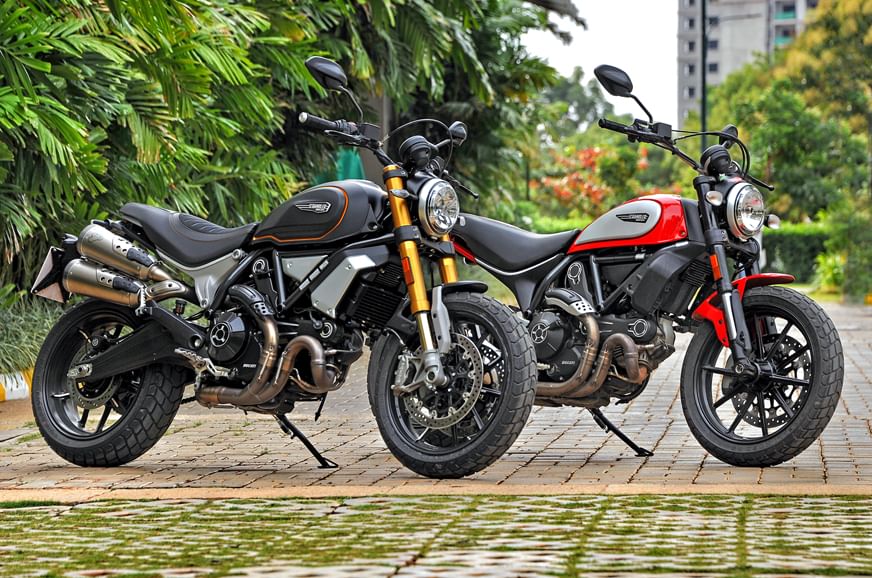2018 Ducati Scrambler 1100 review, test ride
A bigger, faster and considerably more expensive addition to the Scrambler family.
Published on Aug 30, 2018 12:00:00 PM
19,831 Views
I really wanted to love the original Scrambler 800, but it wasn’t meant to be. The suspension was crashy, the throttle far too aggressive (fixed on the BS-IV model) but most of all, the bike struggled to offer a feeling of quality to match its rather optimistic price. The Scrambler 1100 promises to address all those issues and it charges quite a premium in the process. We had a short, two-hour taste of what the bigger Scrambler has to offer and by a draw of chits, I was allocated the most expensive of the three-bike line-up, the Scrambler 1100 Sport.
Sizing up
Being in the first batch of riders, I was on the bike before the crack of dawn, which was a nice opportunity to discover that the headlamp gets the job done well enough, although it’s nowhere close to what the Multistrada that was leading our convoy had to offer. As dawn broke, it revealed that the Scrambler 1100 is a serious step-up from its younger sibling, especially in terms of quality. Everything you see and touch is better finished and components such as the fatter handlebar, adjustable brake/clutch levers and higher quality switchgear all work hard towards justifying the price.
Ducati didn’t want to dilute the Scrambler’s sense of minimalism too much, so the new LCD display looks familiar and is still off-set towards the right, but it now offers more information to the rider. What’s interesting is that the 1100 may look similar to the 800, but it’s a considerably larger motorcycle in the flesh. You feel the extra width in the saddle and parking them side by side reveals that the 1100 is a more substantial machine. It is by no means excessive, and the 1100 is still a very easy machine to manoeuvre, but it lends itself well to customers who like the feel of riding a big bike.

As part of this growth spurt comes a rise in the seat height from 800mm to 810mm. While that doesn’t seem like a lot, the seat is quite wide, so shorter riders are going to want try this on for size first. Further visual differentiators to the 800 come in a more premium finishing for the engine cases, a lovely polished aluminium rear subframe and, of course, that big, dual underseat exhaust. The Sport variant we’re riding here gets a delectable matte-black paint job with yellow detailing, machine finished alloy wheels and a different seat design. It also runs a lower handlebar, although I definitely prefer the higher bar from the standard model - the ergonomics feel just right for a scrambler with that one. Finally, our bike is running an optional (Rs 1.74 lakh!) Termignoni exhaust which has both pipes stacked on top of each other on the right side. It looks neat, but the stock exhaust sounded nicer to my ears with a deep and powerful roar that I certainly wouldn’t change.
Growing gains
So the Scrambler 1100 ticks the right boxes in the visual department - it's a great looking bike and it doesn’t feel built to a price. With a breath of relief, let’s dive under the skin and talk about that big L-twin. It’s certainly not the most modern of engines and this air/oil-cooled, 2-valve motor finds its origins in the old Ducati Monster 1100. But that makes for a part of the appeal and this is a likeable motor that suits the Scrambler really well.
On the move, the engine behaves typical of a big 90-degree Ducati L-twin and it doesn’t like to drop below 2,000rpm. We never countered heavy traffic, but you can expect a juddery experience if you get lazy with the gearbox and clutch. Thankfully, the clutch is reasonably weighted and the motor has vast reserves of torque to offer upwards of this. Since we rode the bike early in the morning in Bengaluru's delightfully chilly weather, I can't tell you just yet if these scrambler-style pipes will cause probelms with heat in stop-go traffic, something that is a bother on the Triumph Street Scrambler. Things stay smooth in the usable rev range and the motor spins up quickly, but get close to the 8-odd thousand rpm redline and it does start getting vibey in the bar and pegs. But this engine is all about what lies between the two extremes of its rev-range and it pulls hard and fast with little effort.
With 86hp and 88Nm, the Scrambler 1100 is more powerful than most machines available in the modern-retro space at this price point, but the Triumph 1200 motors are more torquey. It’s also a big step up from the Scrambler 800 with significantly more shove available at lower engine speeds, and this makes this bike feel vastly quicker and more effortless to ride. Interestingly, it’s also calmer and easier than its smaller sibling and that’s thanks to the smooth torque flow and well-judged throttle response that doesn’t feel jumpy, even though the actual throttle action is quite short. Add in the rich exhaust note, and I thoroughly enjoyed the overall experience.
Identity crisis
Our route for the morning was a quick blast up the famous Nandi Hills road outside Bengaluru. This is a really tight uphill route, with a few sharp corners and hairpins along the way. The room for error is absolutely zero, especially considering the number of distracted motorists heading to the top with selfie modes engaged and excited shrieks directed at everything that comes their way.
The 1100 really excelled here. The bike feels agile despite its 206kg weight and that’s down to a steering rake angle that is almost identical to the Monster 821. This effect that is magnified by the Scrambler’s wide bar and additional steering lock which creates so much more leverage. The Pirelli MT 60 RS tyres continue from the Scrambler 800 and they offer surprising grip despite the blocky design and there was no drama from them in the cold and greasy conditions. Braking performance gets serious too, thanks to a new, dual front disc set-up (the 800 gets one front disc) and Brembo’s incredible M4.32 calipers. This is sportbike-level of kit and we’re talking sharp, one finger performance. The fact that the front tyre is now a sportbike-like 120 section unit, growing from 110 on the normal Scrambler only intensifies the performance, but the front wheel remains an 18-inch unit.
Another big jump from the small Scrambler, and also over the entire competition field, is the new electronics package. Where the Scrambler 800 makes do with just ABS, the 1100 gets advanced cornering-ABS, four stage traction control and three rider modes. The lowest of these modes, City, reduces power to 75hp, mellows down the throttle response and maximises the traction control. Journey mode offers the full 86hp, but with more fluid throttle response while Active gives you sharp responses and sets up the TC for sportier riding. In typical Ducati fashion, the electronics are very well judged and operate transparently in the background.
Then we come to the Sport’s party piece, it’s Ohlins front and rear suspension. Fully adjustable at the front and rebound/preload fully adjustable at the rear, this set-up makes no bones about the fact that it is meant for sporty riding. The Ohlins fork is also a fatter 48mm unit compared with the 45mm unit on the standard model. With 150mm of suspension travel at the front and rear, the Ohlins have the same travel as the Marzocchi fork/Sachs rear set-up (also adjustable) on the standard 1100. While the Ohlins feel more plush and controlled in terms of damping, they are a little firmer than the standard set-up. But to be honest, the difference isn’t very much and the Scrambler 1100 is a rather stiffly set-up motorcycle. This is a continuation of the 800’s philosophy, but the difference is that the 1100’s set-up doesn’t feel cheap.
That brings me to my issue with this motorcycle. I loved riding it on the smooth and winding tarmac, but I wouldn’t want to take it off road. The fact that Ducati didn’t want us to do so on this ride also supports that – and, of course, the fact that it wanted its bikes to come back in one piece! Nevertheless, the suspension set-up is quite like what you’d get on a well-damped sportbike and it makes you aware of every pothole you encounter. The tack-sharp brakes and wider front tyre aren’t something I’d want to deal with off the road either. In essence, the only things genuinely scrambler-like about the Scrambler 11000 are its name, design and ground clearance. At best, the rugged tyres and generous ground clearance mean you can take on rough and broken sections when they come your way, but you certainly won’t go looking for them.
The land of joy
The Scrambler 1100 has no immediate rivals in India, at least until Triumph launches the Bonneville Scrambler 1200, which is currently under works. There is the BMW R9T Scrambler, but it’s far too expensive in India. However, if you look at other modern-retro bikes on sale in India today like the Triumph Bobber or Speedmaster, the new Ducati is a more expensive proposition. Prices start at Rs 10.91 lakh for the base Scrambler 1100 and stretch to Rs 11.42 lakh (all prices ex-showroom) for the Sport, which is a smaller increment than we expected, considering the premium Ohlins suspension generally commands.
It is expensive, but the Scrambler 1100 has its merits of being the most sporty of the lot with much higher levels of braking and suspension kit. It also has the best electronics package and most importantly, it offers the peace of mind of being able to deal with Indian conditions without any serious cause for concern. As long as you’re aware that you’re buying yourself an upright, yet sporty motorcycle and not an off-roader (for that, the Desert Sled is the only serious choice), you’ll like what the Scrambler 1100 has to offer.
Ducati Bikes
Related Videos
Tech Specs
| Price | Petrol |
|---|---|
| Ex-showroom - Delhi | Rs 11.42 lakh (ex-showroom, India) |
| Engine | Petrol |
|---|---|
| Fuel Type | Petrol |
| No of Cylinders | 2-cyl |
| Cubic Capacity (cc) | 1,079cc |
| Engine Layout | L-twin |
| Max Power (hp @ rpm) | 86hp at 7500rpm |
| Max Torque (nm @ rpm) | 88Nm at 4750rpm |
| Transmission | Petrol |
|---|---|
| No of Gears | 6 |
| Suspension | Petrol |
|---|---|
| Front Suspension | 48mm USD fork |
| Rear Suspension | preload/rebound-damping adjustable monoshock |
| Brakes | Petrol |
|---|---|
| Front Brake Type | Disc |
| Rear Brake Type | Disc |
Copyright (c) Autocar India. All rights reserved.



